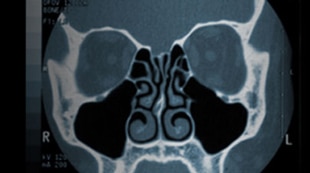WHEN SINUS INFECTIONS BECOME SINUSITIS
That feeling: runny nose, headache, sinus congestion. Is it just a cold? Or something more serious? If it’s a sinus infection, that’s a much more serious condition. In 2011 and 2012, an estimated 1.9 million Australians had chronic rhinosinusitis.1 If someone continues to battle sinus pain, headaches, and emotional drain for 12 weeks or more no matter what treatments they try, they may be dealing with chronic rhinosinusitis (CRS).2,3
WHAT’S HAPPENING IN THE SINUSES?
The sinuses are bony, air-filled cavities inside the face and skull. A sinus infection, also called rhinosinusitis, is an inflammation of the soft tissues that line the sinuses. This inflammation or swelling can stop the sinuses from draining properly. The buildup can then lead to infection, which causes even more inflammation and pain.
There are four types of sinuses — frontal, ethmoid, sphenoid, and maxillary — and sinusitis can affect any of them.

- Frontal sinuses
- Ethmoid sinuses
- Sphenoid sinuses
- Maxillary sinuses
SINUSITIS SYMPTOMS
Sinus congestion, discharge, and pressure with facial pain or headaches could mean a cold. But if the discharge from the nose is yellow or discoloured, it may be a sinus infection.
Chronic sinus infections can reduce a person's quality of life and make them constantly tired. If they have asthma, sinus infections may make it worse.
PHYSICAL SYMPTOMS
- Headaches
- Facial pain or pressure
- Difficulty breathing through the nose
- Nasal discharge that isn't clear
- Fever
- Fatigue
- Upper tooth pain
- Bad breath
TYPES OF SINUSITIS
There are two kinds of sinusitis. A short-term or acute sinus infection can occur after a cold, an allergy attack, or from pollutants in the environment. A long-term or chronic sinus infection is one that lasts longer than 12 weeks.
| Sinusitis Symptom Duration | Sinusitis Type |
|---|---|
| Up to 4 weeks | Acute |
| Longer than 4 weeks, less than 12 weeks | Subacute |
| 12 weeks or longer | Chronic |
| Occurs 4+ times per year, but goes away between episodes | Recurrent acute sinusitis |
CAUSES OF SINUSITIS
Doctors classify the causes of sinusitis this way:
- Anatomical causes — such as a deviated septum or enlarged turbinates in the nose
- Inflammatory and infectious causes — related to bacterial, viral, and fungal infections, as well as allergies and polyps
- Developmental disorders — like cystic fibrosis
- Tumours in the nose and sinuses — these can block critical drainage pathways
The underlying cause behind sinusitis may have implications for how a person responds to treatment and which treatment options the doctor recommends.
RISK FACTORS
These factors can increase the risk of a sinus infection:
- Swimming in polluted water exposes the sinuses to bacteria.
- Frequent contact with young children can expose someone to a greater number of colds or bacterial infections.
- Smoking or secondhand smoke thickens the tissue in the nose, slows down the flow of mucus, and allows bacteria to grow.
DIAGNOSING SINUSITIS

To diagnose a sinus infection, the doctor will ask about symptoms and medical history. They may tap areas of the face to find out if any sinus openings are tender. The doctor may also take a sample of the nasal discharge to determine what kind of infection it might be.
The doctor may order a CT scan that creates images of the inside of the sinuses. This can help the doctor more accurately diagnose the condition and select the best treatment option.4
EXPLORE TREATMENT OPTIONShttps://www.racgp.org.au › afp › june › sinusitis
Rosenfeld RM, Andes D, Bhattacharyva N, et al. Clinical practice guidelines: Adult sinusitis. Otolaryngol Head Neck Surg.2007;137:S1-S31.
Data on File. Medtronic, Inc.
American Rhinologic Society. Sinusitis Q&A. http://care.american-rhinologic.org/sinusitis_q_a? Accessed October 16, 2015.
